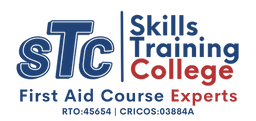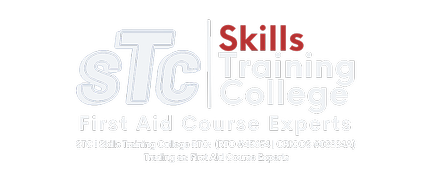Asthma First Aid is the ability to recognise and provide an immediate First Aid response to assist people with asthma or COPD having breathing difficulties or an asthma attack.
What Causes An Asthma Attack?
Asthma is a condition in which the bronchial tubes in your lungs swell and become inflamed. This process produces extra mucus that fills the tubes, making breathing difficult by restricting the amount of oxygen the body can absorb from each breath. Preventors and relievers in the form of inhalers are used to control minor attacks. Serious attacks requiring hospitalisation may involve invasive ventilation, mechanical ventilation and breathing tubes used to provide bronchodilators. Nebuliser machines fill the gap between mild and severe attacks.
Asthma symptoms and triggers, like people, are bespoke and will differ from person to person. The most common reasons asthma is triggered are microscopic airborne particles like pollen, dust mites, mould spores, pet hair or dander.
Intentional exercise or mild physical exertion, in some cases, can bring on a sudden attack. Pet animals, smoke from bushfires, cigarettes, and any toxic particles in the environment can cause breathing difficulties that induce asthma. Allergic reactions to food, drugs, or known allergens may also induce breathing difficulties that lead to asthma or anaphylaxis.
How Do I Give First Aid To Asthma Attacks?
All asthma attacks require an immediate, fast-acting dose of medication. It is delivered on the spot by a Ventolin puffer or inhaler device that contains the specific bronchodilator medication prescribed by a doctor. The 4×4 method is practised in Australia under the ARC guidelines.
The most common reliever medication is salbutamol. This treatment is delivered directly from an inhaler for adults and with a spacer device for children. A written asthma action plan will give specific instructions on how to provide a dose of the medication. A spacer device tube (with a mask for children under four) allows the medication to stay in the tube and be breathed in. The child can breathe four times before repeating the 4×4 method. An adult will require one puff of the inhaler and hold their breath for four seconds before releasing and repeating the steps four times.
How To Give First Aid To Asthma Attack: Without An Inhaler
Asthma attacks can occur randomly and without warning, catching a person off guard and in a place or situation they are unable to access their inhaler. You can still offer First Aid without an inhaler as follows:
· Sit the person upright to open their airway.
· Slow down their breathing by taking long, deep breaths. As deep as they can comfortably.
· Have them breathe in through the nose and out through the mouth to prevent hyperventilation.
· Try to keep them calm. Anxiety or panic will cause the chest and back muscles to tighten, making breathing more difficult, creating more stress and making the situation worse.
· Remove either the trigger or person from the location.
· Caffeine has similar properties to some asthma medications. Drinking a warm coffee might help to temporarily improve breathing and open the airway enough to calm or lessen the person’s anxiety.
· Get medical help. If you can’t get the wheezing, coughing, or breathing difficulties under control, it is essential to call 000.
Have An Action Plan For Asthma Attacks In Schools
Exposure to triggers is inevitable despite precautions. An asthmatic will at some point unavoidably be triggered into having an asthma attack. Therefore, schools require an Asthma Action Plan to treat students and staff effectively.
An Asthma Action Plan is a set of instructions describing how to effectively help you administer First Aid should it be required. Following an action plan will make it clear to the person with this information what medication to give, how much to give, how to operate any devices like a spacer or mask for children, and provide any other valuable information needed to help the person recover without delay.
What Does A Good Asthma Action Plan Include?
· Instructions about your medication and where it is usually kept
· A list of triggers to identify and minimise any further exposure
· Advice on determining what stage your asthma event is and if it is getting worse.
· Emergency contact details
What Are The Signs Of An Asthma Attack?
There are three categories for an asthma attack:
Mild attack
Increased wheezing, coughing, tightness in the chest, shortness of breath, and short sentences before taking a breath.
Moderate attack
Persistent cough, few words or monosyllabic answers, wheezing, clearly having issues with breathing.
Severe Attack
Gasping for air, pale, anxious, is visibly panicked in visible airway distress.
What Are The Signs Of An Asthma Emergency?
· Symptoms rapidly get worse.
· The inhaler treatment does not appear to be working.
· Severe shortness of breath combined with them struggling to speak more than a single word, lips might begin to look blue, and they may become panicked and anxious.
How Do I Assist A Person Having An Asthma Attack?
· Dial 000 to call an ambulance immediately and tell them you have a breathing Emergency.
· If they are conscious and breathing is the most immediate problem, follow DRSABCD First Aid.
Reliever medicine is unlikely to cause any harm to a person, even if they are not asthmatic and having difficulty breathing. Keep them calm and reassure them.
What Are The Most Common Asthma Triggers?
Colds and Flu
Respiratory infections, pneumonia, and pre-existing lung conditions like COPD and Emphysema exacerbate the difficulties when it comes to breathing for a person living with asthma.
Environmental Agents
Industrial pollution, factory exhausts, smog, general air pollution, spring pollen and highly scented flowers all play havoc and can induce asthma attacks.
Cigarette and bushfire smoke
Cigarette smoke has the potential to reduce the effectiveness of your asthma medication. At the same time, it increases your risk of having a severe asthma attack. Actively avoiding locations and situations where people are smoking or gather to smoke during break periods is highly recommended. It can be hard to avoid cigarette smoke in outdoor areas. Using masks with charcoal filters will help mitigate situations where smoke inhalation is unavoidable.
Likewise, bushfires can bring on an attack. The best practice where possible is to stay indoors or wear masks that filter out airborne pollutants when outside.
Exercise
Taking a simple walk on a lovely day might be too much for some. Over-exercising and engaging in strenuous exercise might trigger a mild attack in a gym setting that requires basic First Aid protocols.
What Treatments Are Available For Asthma?
Products like preventers and relievers allow narrow airways to widen, provide quick relief, and restore comfortable breathing in mild cases to prevent and manage attacks and flares. A nebuliser machine with prescribed medication will be used for more severe asthma attacks—dial 000 for emergency medical treatment and hospitalisation via ambulance in extreme cases.
· Puffers (standard MDIs)
· Reliever medication: Asmol, Ventolin
· Chromone preventer medication: Intal, Intal Forte, Tilade
· Corticosteroid-containing preventer medication: Alvesco, Flixotide, Flutiform, Qvar, Seretide, Symbicort
· Dry powder inhalers: Accuhaler, Breezhaler, Ellipta, Genuair and Turbuhaler.
· Mist inhaler: The only mist inhaler is the Respimat, used for the medications Spiriva and Spiolto.
First Aid Awareness
Being First Aid certified is the first step in becoming aware of the people and situations around you that could require First Aid. If you are not already First Aid certified and found this article interesting, check out our FACE Blog page and read some other First Aid and Medically related articles to inspire and educate you. While there, pop over to our courses page, select a course of interest and find a location near you. In no time at all, you can be one of our successful First Aid Responders with a fully accredited, nationally recognised certification in First Aid.


